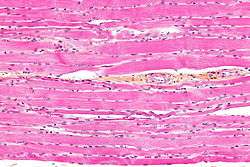Striated muscle tissue
| Striated (Rough) muscle tissue | |
|---|---|
 | |
| Details | |
| Identifiers | |
| Latin | textus muscularis striatus |
| Code | TH H2.00.05.2.00001 |
| TH | H2.00.05.2.00001 |
| FMA | 67905 |
Striated muscle tissue is muscle tissue that features repeating functional units called sarcomeres, in contrast with smooth muscle tissue which does not. The presence of sarcomeres manifests as a series of bands visible along the muscle fibers, which is responsible for the striated appearance observed in microscopic images of this tissue. There are 3 types of specific striated muscles, these being:
- Pharyngeal muscle (embryologically different from skeletal muscle)
- Cardiac muscle (heart muscle)
- Skeletal muscle
Contractions in striated muscles are voluntary, except for the heart muscle, in which contractions are regulated involuntarily by the sinoatrial node. Cardiac muscle is often treated separately from the other striated muscles, as it has somewhat different characteristics.[1] During voluntary contractions, a striated muscle is extended by the action of an antagonistic muscle. All skeletal muscles are attached to some component of the skeleton, unlike smooth muscle which comprises hollow organs such as the intestines or blood vessels. The fibers of striated muscle have a cylindrical shape with blunt ends, whereas those in smooth muscle can be described as being spindle-like with tapered ends. Two other characteristics that differentiate striated muscle from smooth muscle are the facts that the former has higher amounts of mitochondria and contains cells that are multinucleated.[2]
References
- ↑ "Striated muscle". Mosby's Dictionary of Medicine, Nursing & Health Professions (9th ed.). 2012.
- ↑ "Muscle Physiology - Introduction to Muscle". muscle.ucsd.edu. Retrieved 2015-11-24.